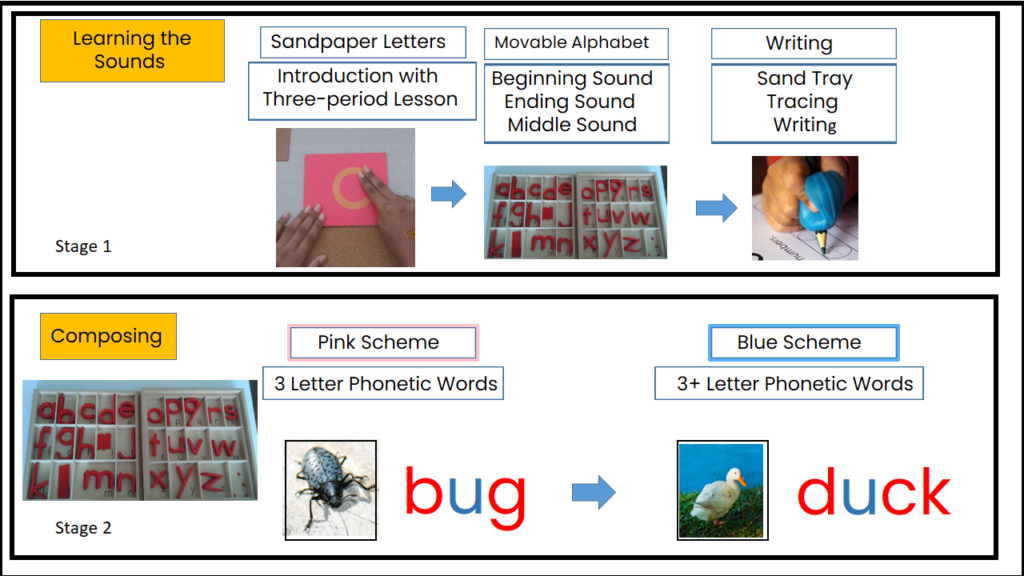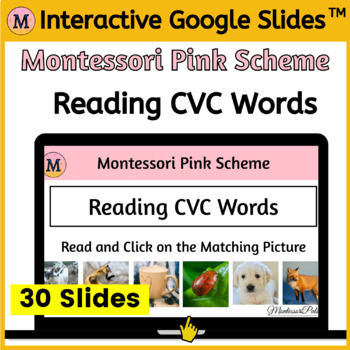Table of Contents
If you are new to homeschooling your preschooler like many other parents in 2021, this post is for you. This simple phonetic reading guide will answer many of your Montessori and preschool reading-related questions. There are tons of Montessori resources available on the internet. But you might not know when and how to use those resources. The Montessori method is methodical and taking a step-by-step approach is crucial.
The Montessori method uses lots of hands-on materials. But if you are not ready to invest in those, you can easily make them at home. Find out How to make your own basic materials with free printables here.
[mailpoet_form id=”22″]
Montessori Phonetic Reading
Introducing the sounds.

Materials: Sandpaper Letters, The Movable Alphabet
Technique: The three-period lesson
Sandpaper Letters
Introduce the sounds using the Sandpaper Letters. You can find out how to perform a three-period lesson from my previous blog post, “The Best Strategy to Teach New Words – Montessori Method” The Three-period lesson is the Montessori technique to teach new words.
Movable Alphabet
When the child knows a few sounds, show him how to match them with pictures using the Movable Alphabet. Beginning and ending sound words can be any word as long as the first/last sound is phonetic. E.g., ball. “Ball” is not a phonetic word. But it’s ok because the child’s attention should only go to the initial sound.
If you are not sure about the phonetic sounds, get the Phonetic Alphabet guide
Choose CVC words only for the middle sound. I have explained everything you need to know about this level in detail in one of my blog posts. “How to Teach Phonics to Preschoolers”
Composing
Materials: Movable Alphabet, objects or pictures cards
Composing is the exact opposite of reading. Many teachers get these two stages confused. This can have a negative effect on the child’s reading journey. At this stage, the child is not ready to read (synthesis) yet. If you give a child a reading activity at this stage, it can discourage him. The best way to clarify the difference is to give the picture first. The child looks at the picture, says what it is, and then finds the sound he hears to compose the word.
Pink Scheme ( Three-letter phonetic /CVC words)
Have a set of objects or picture cards of three-letter phonetic words. E.g., cat, mug, pen, bin, box. Show one card and ask the child to say the word. The child should be familiar with identifying the beginning, ending and middle sounds. Show the child how to compose the word with the Movable Alphabet.

Teacher: “What’s the first sound you hear when you say cat?”
Child: “c”
Teacher: “Could you find “c” from the Movable Alphabet for me please”
Teacher: “What’s the last sound you hear when you say cat?”
Child: “t”
Teacher: “Could you find “t” from the Movable Alphabet for me please”
Teacher: “What’s the sound you hear in the middle of “c” and “t”?”
Child: “a”
Teacher: “Could you find “a” from the Movable Alphabet for me please”
Usually, they can easily identify the beginning and ending sound. Many children have a little difficulty identifying the middle sound. It’s normal. Don’t get discouraged. You can try saying the word slowly and breaking it down. With practice, The child will eventually learn that
Blue Scheme
The Blue Scheme has phonetic words that have 4 or more letters. The method to present is exactly the same as the Pink Scheme.
Reading:

Reading a word is the complete opposite of composing a word. At this stage, the child should be given a word first. He has to read and find out the picture or the object. Start with word cards and objects/picture cards. It is easy for the child to choose when there are pictures available. Take your time and slowly move on to Sheets, Booklets and Lists.
Pink Scheme
Pink Word Cards and Object/Picture Cards
This is a Montessori shelf activity. Make boxes containing 6 Picture Cards and 6 Word Cards in each. Keep them available on the shelf for the child to use. The child should read a word card first and find the matching picture. (This is the opposite of composing)
Pink Sheets with Loose Word Cards
This is a shelf activity as well. The pictures are printed on sheets and the matching word cards are loose. The child should take one word card at a time, read and match with the picture on the sheet.
Pink Booklets
These are tiny booklets with only one word on each page. This is kind of preparation for the child to read storybooks later. There should be no pictures. The child is slowly getting used to reading words without visual aids. Because there are no pictures you can use more abstract CVC words like hug, mad, bad…etc. Keep a few booklets on a tray and make them available on the shelf.
Pink Lists
You can use abstract CVC words for the lists as well because there are no pictures. Make a few laminated lists, keep them on a tray and make them available on the shelf.
Blue Scheme
- Blue Word Cards and Object/Picture Cards
- Blue Sheets with Loose Word Cards
- Blue Booklets
- Blue Lists

Blue Scheme activities are done exactly the same as the Pink Scheme. The only difference is they are longer phonetic words.
Nouns
Classroom Nouns
Montessori Noun Cards are black. Have a set of phonetic Noun Cards. The nouns can be taken from classroom objects. Ask the child to read each card and keep the cards next to the object. This is an engaging activity. Because the child will be walking around the classroom looking for the objects.
Farm Nouns
After the classroom o, you can introduce phonetic Farm Nouns with Picture Cards. This is a special activity that we use to teach grammar by adding verbs, adjectives, articles…etc.
Singular and Plural
Have a set of phonetic nouns and a set of their plurals. Choose phonetic nouns with simple plurals. Avoid -es plurals and irregular plurals. Show the child how to read the singular noun first and find the matching plural noun. You can even use tiny objects to show the singular/plural concept.
Verbs
Montessori Verb Cards are red in colour. Have a set of phonetic Verb Cards. Ask the child to read and do the verb. Match with farm animal nouns to make a short phrase. E.g., cat sits, duck swims
Adjectives
Montessori Adjective Cards come in blue. This blue is a different shade than the blue scheme. To do this activity you need to have a set of Adjective Cards as well as Noun Cards to go with them. Show the child how to make a short phrase by putting a noun and an adjective together. You can put the adjective card after the noun, ask the child to read. “cat black”. Let the child fix the syntax error. When the child gets enough practice add in verb cards. Try to get the child’s attention to the word order.

Articles
Articles are not phonetic. The only way to learn them is to memorize them. You can introduce and review them in circle time. Make sure to introduce both lowercase and uppercase articles. Because if they come at the beginning of a sentence, they should be uppercase.
Sight Words

Sight words are not phonetic either. they should be memorized as well. Circle time, Word Wall activities, and worksheets are ways to practice sight words. The child needs to know them at this stage to be able to read Sentences.
Once the child learns the articles and a few sight words, you can introduce Sentences. This is a good time to introduce Uppercase letters and period.
Sentences
Sentences come in 2 difficulty levels for both Pink and Blue Sentences
- Sentences with the matching picture. These are a great way to get the child familiarised with reading sentences.
- Sentences with three choices of pictures. The child should read and find the matching picture. These sentence cards are engaging and improve reading comprehension.

Story Books
These stories consist of 5-10 phonetic sentences except for articles and sight words.
- Pink Story Books: All the sentences have 3-letter phonetic words only.
- Blue Story Books: All the sentences with phonetic words with 4+ letters.
Conclusion
Montessori Phonetic Reading has few stages. This illustrated guide will help you find out your child’s level, so you can continue from there. This is a rough guide and outline to get an idea of the sequence you should follow. The child does not have to complete one level to move on to the next level. For example, when the child knows a few sounds he can start composing three-letter words. you don’t have to wait till you introduce all the sounds.
Let’s Keep in Touch. Get updates on new Free Montessori Printables.
Facebook – https://www.facebook.com/MontessoriPulse
Pinterest – https://www.pinterest.ca/MontessoriPulse/_created/
Instagram – https://www.instagram.com/paminiw/
Resource Library – https://www.montessoripulse.com/resources/

